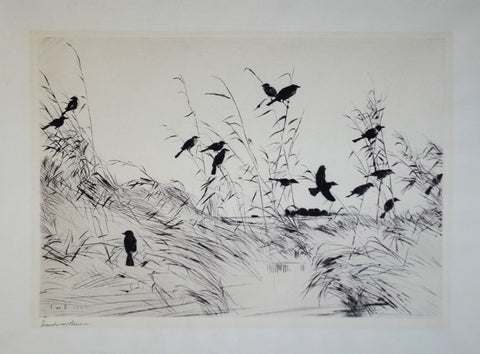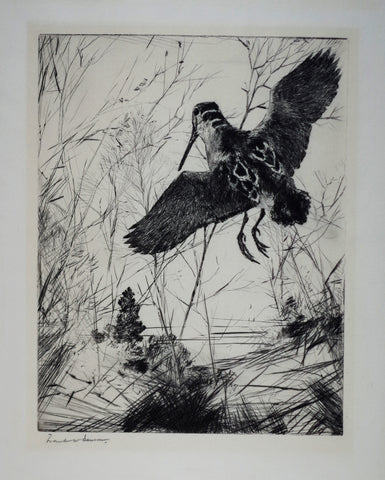Search By Artist
Frank Weston Benson (1862-1951)
Bird etchings
Various dates
Frank Weston Benson (1862-1951) was an American Impressionist artist, and a member of the Ten American Painters. He began his Studies at the school of the Museum of Fine Arts, Boston in 1879, under Otto Grundmann, and later studied at the Académie Julian in Paris. Upon return to America, he would become an instructor at the School of the Museum of Fine Arts, Boston.
In 1888 Benson gained favorable attention in his first showing with the Society of American Artist in New York, with a piece that suggested the influence of academic Realism rather than Impressionism. By the early 1890s he began using his family as subjects; Benson later recalled having realized at the time that “design” was the most important component of painting. Consequently, works of the period provided evidence of a greater interest in patterns, silhouette, and abstract design.
Late in his career, Frank Benson returned his boyhood interest in ornithological illustration. Following the 1913 Amory Show, Benson quietly moved to revolutionize the field of American sporting art. His rendering of wildlife, hunting, fishing, and camping infused the field with heightened artistic sensitivity, and reinvigorated a tradition- burdened field.
Historical accounts indicate that Benson’s teenage bird studies were extremely realistic. We can infer that they were similar to works by Alexander Pope (American, 1849-1924) and Louis Agassiz Fuertes (American, 1874-1927). Those painters concentrated on painting objects with precision. Each blue jay painted by Fuertes had exactly the same color tones and patterns. This is realism in the sense that twelve jays in a cage look precisely the same.
In contrast, Benson’s artistic training brought him to realize that a viewer’s experience of a jay’s appearance varies with the tint of light cast by the sky, whether the jay is front lit or backlit, and the background. Furthermore, Benson realized that we did not perceive the precise feather pattern of a bird at a distance of 20 feet. Benson had learned that our eyes perceive light, not objects, and he introduced that realization into the sporting art field. Other artists such as Roland Clark, A. L. Ripley, and Richard Bishop quickly followed his lead.
In 1915 he first exhibited etchings of wild fowl, to popular acclaim. After 1920 Benson turned increasingly to the depiction of landscapes featuring wild life, an outgrowth of his interest in hunting and fishing, from then on producing a steady and profitable output of etchings and watercolors in this vein. At the request of fellow artist and conservationist Jay Norwood “Ding” Darling, Benson designed the second Federal Duck Stamp on 1935.
In 1888 Benson gained favorable attention in his first showing with the Society of American Artist in New York, with a piece that suggested the influence of academic Realism rather than Impressionism. By the early 1890s he began using his family as subjects; Benson later recalled having realized at the time that “design” was the most important component of painting. Consequently, works of the period provided evidence of a greater interest in patterns, silhouette, and abstract design.
Late in his career, Frank Benson returned his boyhood interest in ornithological illustration. Following the 1913 Amory Show, Benson quietly moved to revolutionize the field of American sporting art. His rendering of wildlife, hunting, fishing, and camping infused the field with heightened artistic sensitivity, and reinvigorated a tradition- burdened field.
Historical accounts indicate that Benson’s teenage bird studies were extremely realistic. We can infer that they were similar to works by Alexander Pope (American, 1849-1924) and Louis Agassiz Fuertes (American, 1874-1927). Those painters concentrated on painting objects with precision. Each blue jay painted by Fuertes had exactly the same color tones and patterns. This is realism in the sense that twelve jays in a cage look precisely the same.
In contrast, Benson’s artistic training brought him to realize that a viewer’s experience of a jay’s appearance varies with the tint of light cast by the sky, whether the jay is front lit or backlit, and the background. Furthermore, Benson realized that we did not perceive the precise feather pattern of a bird at a distance of 20 feet. Benson had learned that our eyes perceive light, not objects, and he introduced that realization into the sporting art field. Other artists such as Roland Clark, A. L. Ripley, and Richard Bishop quickly followed his lead.
In 1915 he first exhibited etchings of wild fowl, to popular acclaim. After 1920 Benson turned increasingly to the depiction of landscapes featuring wild life, an outgrowth of his interest in hunting and fishing, from then on producing a steady and profitable output of etchings and watercolors in this vein. At the request of fellow artist and conservationist Jay Norwood “Ding” Darling, Benson designed the second Federal Duck Stamp on 1935.





